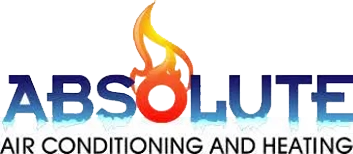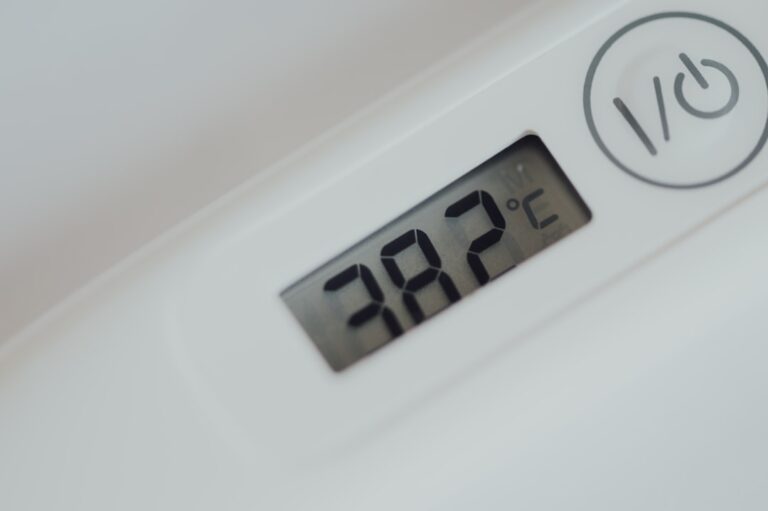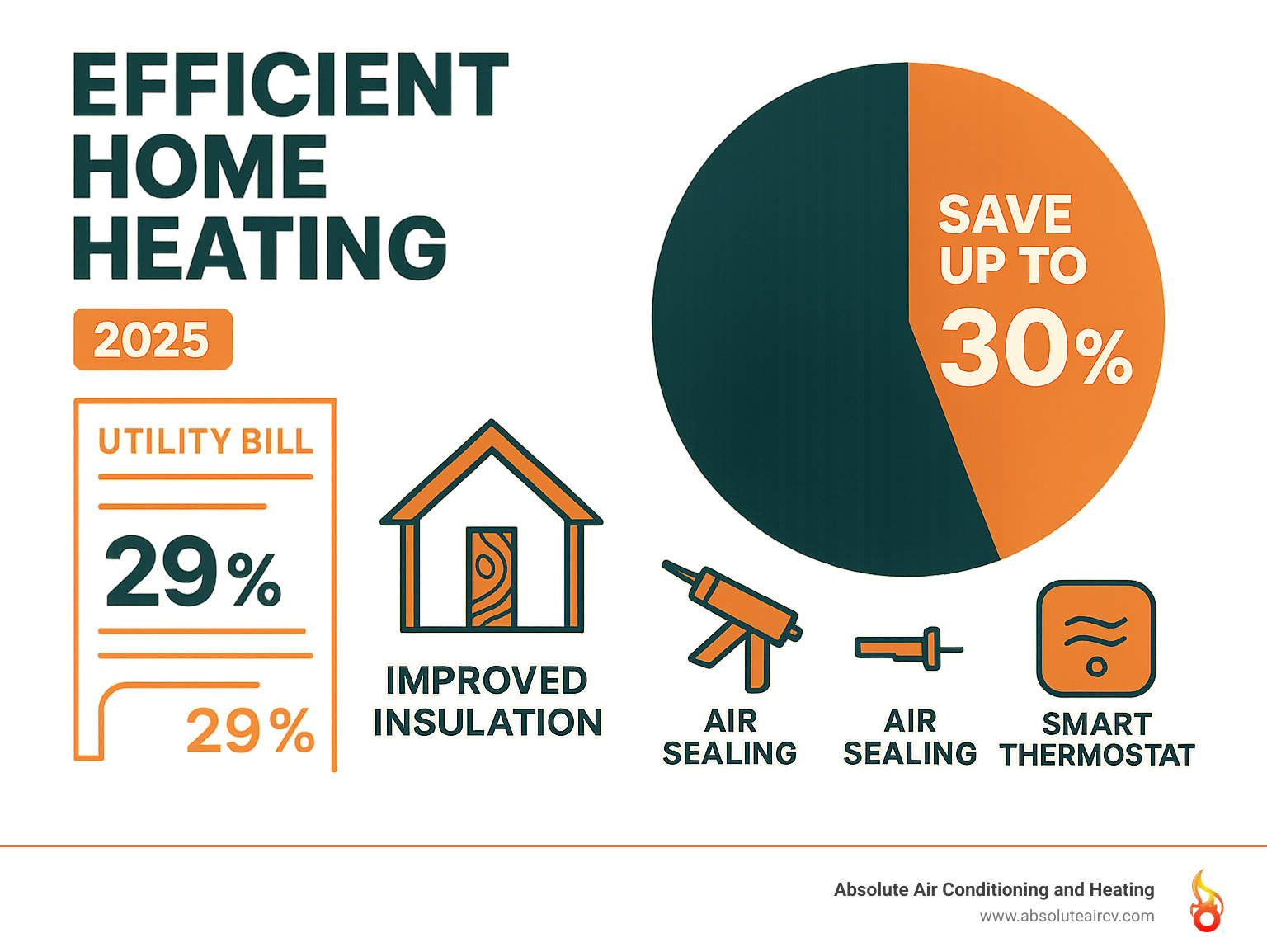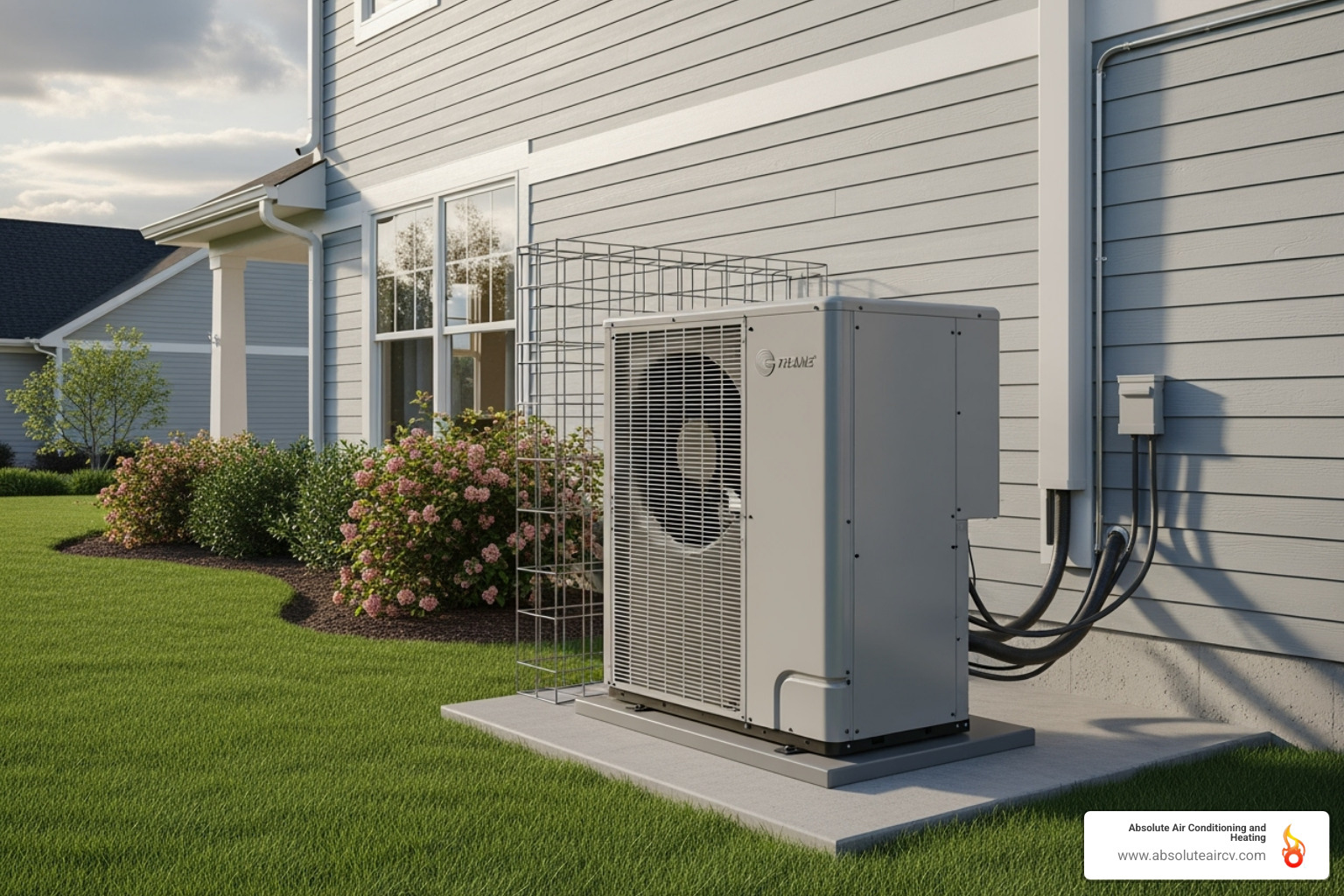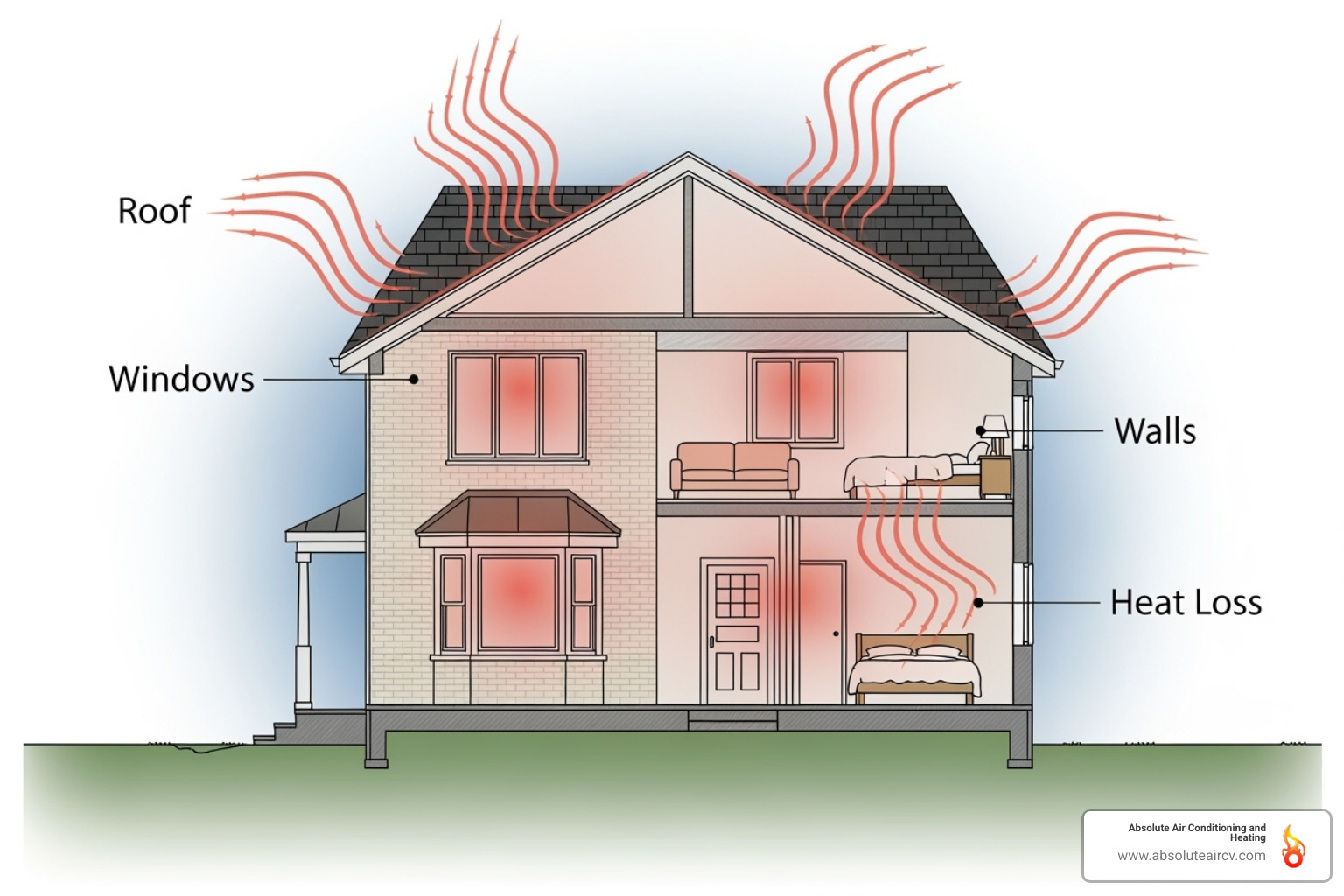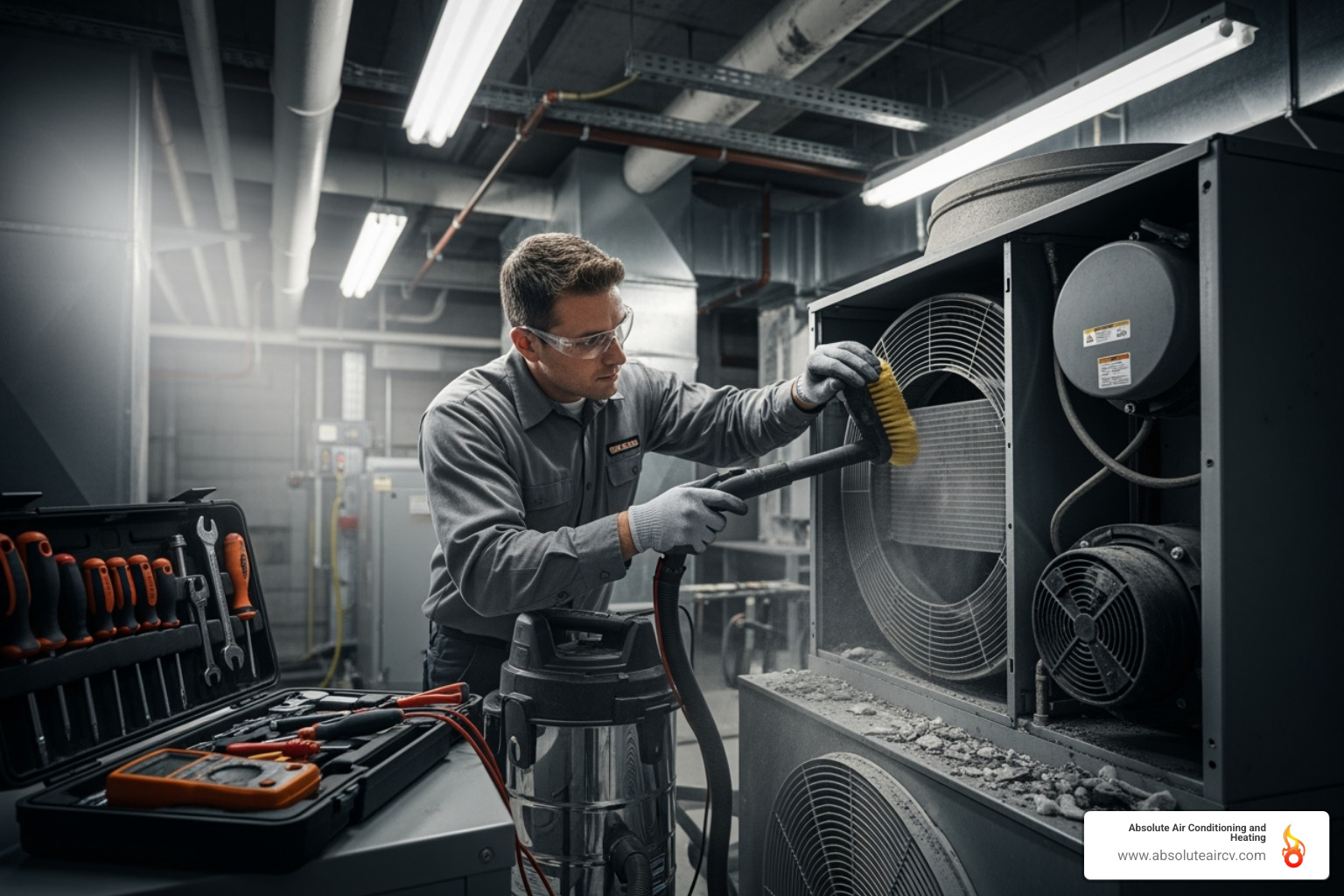Your Guide to a Warmer, More Cost-Effective Home
Efficient home heating isn’t just about staying warm—it’s about smart energy use that keeps your utility bills in check. With heating typically making up about 29% of your utility bill, the right approach can save you around 30% on your energy costs through proper equipment, insulation, air sealing, and thermostat management.
The most efficient home heating systems:
- Geothermal heat pumps: Up to 450% efficiency by using ground temperature
- Air-source heat pumps: Up to 275% efficiency in moderate climates
- High-efficiency gas furnaces: Up to 95% AFUE rating
- Modern boilers: 90-98% efficiency with condensing technology
- Electric resistance heating: 100% efficient but highest operating costs
Key factors for maximum efficiency:
- Proper insulation and air sealing to prevent heat loss
- Smart thermostats for optimized temperature control
- Regular maintenance to keep systems running at peak performance
- Sealed ductwork to prevent up to 30% heat loss through leaks
The biggest efficiency gains come from taking a whole-house approach. This means looking beyond just your heating equipment to include your home’s insulation, air tightness, and how all the pieces work together.
Whether you’re comparing heating systems or trying to squeeze more efficiency from your current setup, the right combination of equipment and home improvements can dramatically cut your heating costs while keeping you more comfortable.
Comparing the Most Energy-Efficient Heating Systems
When it comes to efficient home heating, the system you choose will be your home’s hardest-working appliance for years to come. Think about it—your heating system runs for months at a time, so even small differences in efficiency can add up to huge savings (or costs) on your utility bills.
The key to understanding heating efficiency is knowing how we measure it. For furnaces and boilers, we use AFUE (Annual Fuel Utilization Efficiency), which tells you what percentage of fuel actually heats your home versus what gets wasted. Heat pumps use something called COP (Coefficient of Performance), which measures how many units of heat you get for each unit of electricity consumed.
The Most Efficient Home Heating Systems Compared
Let’s break down your main options and see how they stack up. Each system has its sweet spot depending on your climate, existing setup, and budget.
| System Type | Typical Efficiency Rating | Upfront Cost | Best Climate |
|---|---|---|---|
| Geothermal Heat Pump | 450-600% COP | High | All climates, especially cold |
| Air-Source Heat Pump | 275-300% COP | Moderate to High | Moderate to cold climates |
| High-Efficiency Furnace (Natural Gas/Propane) | 90-98% AFUE | Moderate | Cold climates |
| High-Efficiency Boiler (Natural Gas/Oil) | 90-98% AFUE | Moderate to High | Cold climates, hydronic systems |
| Electric Resistance Heating (Baseboard/Radiant) | 100% | Low | Supplemental heat, mild climates |
Geothermal & Air-Source Heat Pumps: Moving Heat, Not Making It
Here’s where things get really interesting. Heat pumps don’t actually create heat—they’re more like heat movers. In winter, they grab heat from outside (even when it’s cold!) and bring it inside. In summer, they flip the script and move heat from inside your house to the outdoors.
This clever approach is why heat pumps can achieve efficiencies over 100%—sometimes way over. A geothermal heat pump can reach 450% efficiency or higher because it taps into the earth’s steady underground temperature. An air-source heat pump might deliver 275% efficiency by pulling heat from outdoor air.
Think of it this way: for every dollar you spend on electricity, you might get three or four dollars’ worth of heating. That’s pretty amazing when you compare it to old-school electric heaters that give you exactly one dollar of heat for every dollar spent.
Air-source heat pumps work beautifully in our desert climate here in Palm Desert. The mild winters mean they don’t have to work as hard, and they pull double duty by cooling your home in summer. We’ve seen the benefits of heat pump installation for local homeowners, and the energy savings can be substantial.
If you’re curious whether a heat pump makes sense for your home, we can help you figure out the right heat pump for your home based on your specific needs and setup.
High-Efficiency Furnaces and Boilers
Don’t count out furnaces and boilers just yet. Today’s high-efficiency furnaces and boilers are light-years ahead of the energy hogs from decades past. That old boiler in your basement might waste nearly half the fuel it burns, but a modern unit can achieve 95% AFUE or better.
The secret sauce is condensing technology. These smart systems capture heat from exhaust gases that older systems just sent up the chimney. It’s like getting a second helping of heat from the same amount of fuel.
Natural gas furnaces and propane furnaces with high AFUE ratings make excellent choices, especially if you already have gas lines to your home. They’re reliable workhorses that can handle even the coldest nights without breaking a sweat.
Regular maintenance keeps these systems humming at peak efficiency. Our furnace services in Palm Desert, CA ensure your system stays in top shape year after year. For deeper technical details, the Department of Energy has more on furnace and boiler efficiency worth checking out.
Understanding Electric Heating Options
Electric heating gets a bad rap, and honestly, some of it’s deserved. Baseboard heaters and basic radiant floor heating are 100% efficient at turning electricity into heat—every bit of power becomes warmth. Sounds perfect, right?
Here’s the catch: electricity costs can be brutal. While these systems don’t waste any energy, they can waste your money if electricity rates are high in your area. Electric resistive heating works fine for small spaces or occasional use, but heating a whole house this way can send your utility bills through the roof.
The one exception? Heat pumps. Since they move heat instead of creating it, they’re the most efficient electric option by far. In our moderate climate, an air-source heat pump gives you all the benefits of electric heating without the shocking utility bills.
If you’re stuck with electric heating, radiant floor heating is probably your best bet for comfort. It warms you from the ground up and creates very even temperatures throughout the room. Just be prepared for higher operating costs compared to heat pumps or gas systems.
The Whole-House Approach to Efficient Home Heating
Here’s the thing about efficient home heating: even the most advanced heat pump or furnace won’t save you money if your home can’t hold onto the heat it produces. It’s like trying to fill a bucket with holes in it—no matter how fast you pour, you’re fighting a losing battle.
That’s why we always recommend taking a whole-house approach. Your heating system is just one piece of the puzzle. The real magic happens when everything works together: your equipment, insulation, air sealing, and smart controls all doing their part to keep you comfortable while keeping costs down.
The Critical Role of Insulation and Air Sealing
Think of your home’s building envelope—the walls, roof, windows, and foundation—as a thermal boundary that keeps the good air in and the bad air out. When this boundary has gaps, cracks, or insufficient insulation, your heating system has to work overtime to maintain comfortable temperatures.
The biggest energy wasters are often hiding in plain sight. Attic insulation is crucial because heat naturally rises, and without proper insulation up there, you’re literally heating the great outdoors. Wall insulation keeps warmth from escaping through your exterior walls, while proper air sealing tackles those sneaky little gaps around windows, doors, electrical outlets, and where pipes enter your home.
These air leaks might seem small, but they add up fast. A professional blower door test can reveal exactly where your home is losing conditioned air—sometimes the results are surprising! Simple fixes like weatherstripping around doors and windows or caulking small gaps can make a noticeable difference in both comfort and energy bills.
When we seal up these leaks and add proper insulation, we’re not just saving energy. We’re creating a home that feels more comfortable year-round, with fewer drafts and more consistent temperatures from room to room.
How Smart Thermostats Boost Efficiency
Once your home can actually hold onto the heat, the next step is controlling when and how much heat you need. This is where smart thermostats really shine, and they’re a game-changer for efficient home heating.
Gone are the days of basic programmable thermostats that were more complicated than helpful. Today’s smart thermostats use learning algorithms to understand your schedule and preferences. They can tell when you’re away using geofencing technology, automatically adjusting temperatures so you’re not heating an empty house.
Remote access means you can adjust your heating from anywhere—stuck at work late? Lower the temperature from your phone. Coming home early? Warm things up before you arrive. Many smart thermostats even provide energy use reports that show exactly how your heating habits affect your bills.
The beauty of these systems is that they make efficiency effortless. You don’t have to remember to turn down the heat when you leave or constantly fiddle with settings. The thermostat handles the optimization for you, often saving 10-15% on heating costs without any sacrifice in comfort.
Don’t Forget Your Ductwork
Here’s something that might surprise you: if you have a forced-air heating system, your ductwork could be sabotaging your efficiency efforts. Leaky ducts are like having holes in the delivery system between your heating equipment and your living spaces.
Energy Star estimates that homes lose up to 30% of heated air through duct leaks. That means nearly a third of the energy you’re paying for never actually reaches the rooms where you need it. Instead, it’s heating your attic, crawl space, or the inside of your walls—spaces that don’t need conditioning.
Proper airflow through sealed ducts ensures that every bit of heated air your system produces actually makes it to your living areas. Professional duct sealing not only improves efficiency but also helps with indoor air quality and comfort.
If you’re in the Palm Desert area, our team can assess your ductwork and identify any issues that might be costing you money. We provide comprehensive Ducting Services in Palm Desert, CA to make sure your heating system delivers every bit of comfort you’re paying for.
Maximizing Your Current System & Planning for Upgrades
Maybe you’re not ready to replace your entire heating system just yet—and that’s perfectly okay! There are plenty of ways to boost your current system’s performance while you plan for future upgrades. Think of it like getting the most out of your trusty old car while you save up for that dream vehicle.
Simple Steps to Improve Existing System Performance
Your heating system is a lot like your car—regular care keeps it running smoothly and efficiently. The difference? A well-maintained heating system can actually increase efficiency by up to 40% and prevent 95% of those dreaded middle-of-winter breakdowns.
Regular maintenance is absolutely crucial for efficient home heating. Just like you wouldn’t skip oil changes for your car, your furnace or heat pump needs annual tune-ups to stay in peak condition. Our factory-trained technicians know exactly what to look for during these visits, and most manufacturers actually require this maintenance to keep your warranty valid. We’ve seen how the Importance of Regular Heating Services can transform a struggling system, and proper care can help you Extend HVAC Lifespan with Service.
Changing your air filter might seem like a small thing, but a clogged filter forces your system to work 15% harder. That’s like trying to breathe through a stuffy nose—everything becomes more difficult! Check your filter monthly and swap it out every 1-3 months, or more often if you have furry friends or family members with allergies.
Clearing your vents is another easy win. We’ve seen beautiful homes where expensive furniture blocks half the heating vents. Your system can’t heat what it can’t reach, so make sure supply and return vents have plenty of breathing room.
These simple steps might not sound glamorous, but they can dramatically improve your comfort while keeping energy bills in check.
Factoring in Fuel Costs
Here’s something many homeowners overlook: even the most efficient system won’t save you money if it runs on expensive fuel. It’s like having a super-efficient car that only runs on premium gas—the efficiency gains might get eaten up by fuel costs.
Natural gas, propane, electricity, and oil all have different price points, and these costs can swing dramatically from season to season. Even a 100% efficient electric resistance heater might cost more to operate than a 90% efficient gas furnace if electricity rates are high in your area.
The numbers can be eye-opening. Switching from an old 78% efficient oil furnace to a modern ground-source heat pump could save you over $1,600 annually. Even switching to natural gas from that same old oil furnace could save over $1,100 per year, while an air-source heat pump might save around $960 annually.
These examples show why fuel costs matter just as much as efficiency ratings when planning your heating strategy. It’s not just about the percentage—it’s about your actual monthly bills.
Rebates and Incentives for Upgrades
Here’s some good news: you don’t have to go it alone when upgrading to more efficient home heating. Federal, state, and local programs often offer substantial rebates and tax credits for energy-efficient upgrades.
Federal tax credits can significantly reduce the upfront cost of installing ENERGY STAR certified heat pumps or high-efficiency furnaces. Many local utility companies also offer rebates for specific equipment upgrades. These incentives can make a big difference in your return on investment.
We always encourage our Palm Desert, Indian Wells, Rancho Mirage, and Palm Springs customers to explore these opportunities before making any major heating decisions. You can find current government incentives for energy efficiency to see what’s available in your area.
Common upgrades that qualify for rebates include ENERGY STAR certified air-source and geothermal heat pumps, high-efficiency natural gas furnaces and boilers, advanced smart thermostats, and even comprehensive home energy audits that help identify improvement opportunities.
Taking advantage of these programs can turn an expensive upgrade into a smart financial move that pays dividends for years to come.
Frequently Asked Questions about Efficient Home Heating
As a family-owned HVAC business serving Palm Desert and the surrounding areas, we get asked the same questions over and over again. Let’s clear up some common misconceptions and give you the straight facts about efficient home heating.
Is it cheaper to leave the heat on low all day or turn it on when needed?
Here’s a myth that just won’t die! So many homeowners tell us they keep their heat on low all day because they think it’s more efficient than letting the house get cold and then warming it back up. We totally understand the logic—it seems like it would take more energy to heat a cold house from scratch.
But here’s the thing: your home loses heat constantly, even when the heating is on. The warmer your house is compared to the outside temperature, the faster it loses heat. When you leave your heating on all day, you’re constantly fighting that heat loss, even when nobody’s home to enjoy the warmth.
The most cost-effective approach is actually to only heat when you need it. Let the temperature drop when you’re asleep or away, then bring it back up when you’re home and awake. A programmable or smart thermostat makes this effortless—no more remembering to adjust the temperature before you leave for work!
Your heating system is designed to handle temperature swings. It’ll work efficiently to bring your home back to comfort, and you’ll save money by not heating an empty house all day long.
How much can I really save with an efficient heating system?
This is the big question everyone wants answered, and we love sharing the good news! You can typically save about 30% on your energy bills when you combine an efficient heating system with proper insulation, air sealing, and smart thermostat use.
Of course, your actual savings depend on what you’re starting with. If you’ve got an old system that’s been limping along for years, your savings could be dramatic. We’ve seen homeowners switching from an old oil furnace to a ground-source heat pump save over $1,600 annually—that’s real money back in your pocket!
The key factors that determine your savings include your current system’s efficiency, how well your home is insulated and sealed, and local fuel costs. Even upgrading from an older gas furnace to a modern high-efficiency model can make a noticeable difference in your monthly bills.
Every home is different, which is why we always recommend a professional assessment. The EIA’s residential energy studies provide detailed comparisons if you want to dive deeper into the numbers, but we’re always happy to help you understand what realistic savings might look like for your specific situation.
Does turning off radiators in unused rooms save money?
Absolutely! This is one of our favorite efficient home heating tips because it’s so simple yet effective. Closing off unused rooms is like zoning your heating system—you’re directing all that warm air to where you actually need it.
When you turn off radiators (or close vents in forced-air systems) in guest bedrooms, storage rooms, or other spaces you rarely use, your heating system doesn’t have to work as hard. Your boiler or furnace can focus on heating the occupied areas, which means it runs more efficiently and cycles off sooner.
Here’s the key: don’t forget to close the doors to those unused rooms too. Otherwise, the warm air from your heated spaces will just drift in and your system will keep working to heat those areas anyway.
This simple strategy reduces your overall heating load and can lead to noticeable savings on your energy bills. It’s one of those no-cost improvements that just makes sense!
Achieve Peak Comfort and Efficiency in Your Home
When it comes to efficient home heating, there’s no magic bullet or single solution that solves everything. Instead, think of it like putting together a puzzle where every piece matters—your heating equipment, your home’s insulation, your thermostat settings, and even your daily habits all play important roles in creating the complete picture of comfort and savings.
The beauty of taking this comprehensive approach is that small improvements add up to big results. Maybe you start with sealing some air leaks around windows and doors, then upgrade to a smart thermostat, and eventually invest in a new high-efficiency heat pump. Each step builds on the others, creating a home that’s not only more comfortable but also gentler on your wallet and the environment.
We’ve seen this change countless times in homes throughout Palm Desert, Indian Wells, Rancho Mirage, and Palm Springs. A family might start with a simple maintenance call, but once they understand how all these pieces work together, they often find opportunities they never knew existed. Maybe their ductwork was leaking precious heated air into the attic, or their old furnace was working overtime because of poor insulation.
At Absolute Air Conditioning & Heating, we’re passionate about helping our neighbors achieve that perfect balance of comfort and efficiency. As a locally family-owned business, we understand the unique climate challenges of the Coachella Valley. Our factory-trained technicians don’t just fix problems—they help you see the bigger picture and make informed decisions about your home’s comfort system.
Whether you’re dealing with sky-high utility bills, uneven temperatures throughout your home, or an aging system that’s on its last legs, the path to efficient home heating starts with understanding your options. Every home is different, and what works perfectly for your neighbor might not be the best solution for you.
That’s why we believe in taking the time to really understand your specific situation, your budget, and your comfort goals. For expert advice on the best heating solutions for your Palm Desert home, explore our comprehensive heating services. We’re here to help you open up the full potential of your home’s heating system and create the comfortable, efficient home you deserve.
